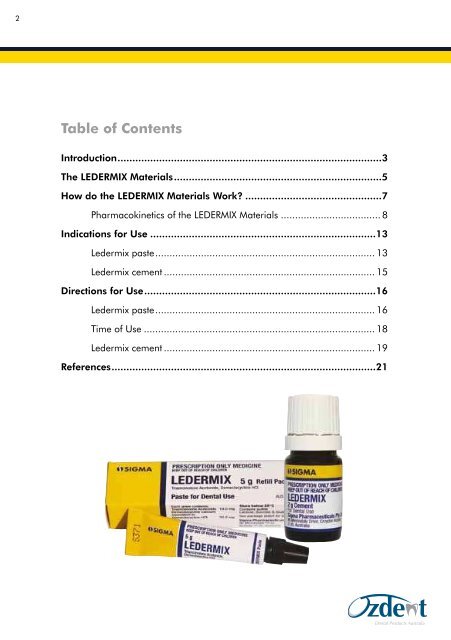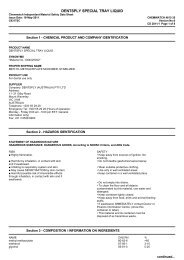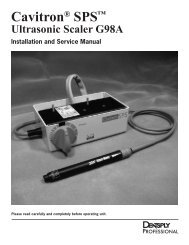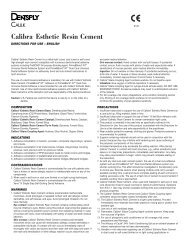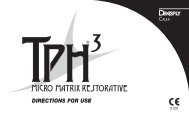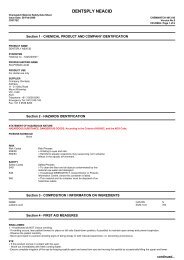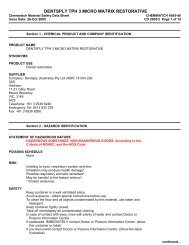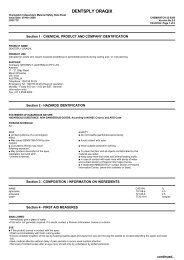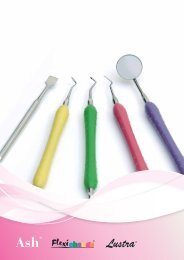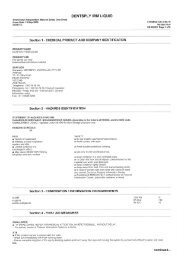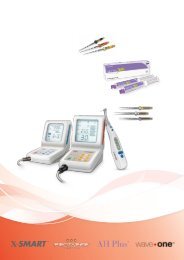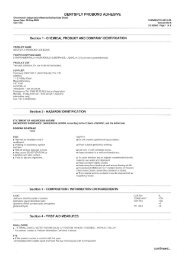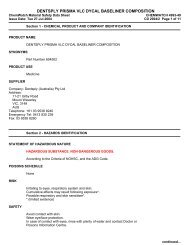The Materials - Dentsply
The Materials - Dentsply
The Materials - Dentsply
Create successful ePaper yourself
Turn your PDF publications into a flip-book with our unique Google optimized e-Paper software.
2 3<br />
<strong>The</strong><br />
<strong>Materials</strong><br />
Table of Contents<br />
Introduction.........................................................................................3<br />
<strong>The</strong> LEDERMIX <strong>Materials</strong>......................................................................5<br />
How do the LEDERMIX <strong>Materials</strong> Work?...............................................7<br />
Pharmacokinetics of the LEDERMIX <strong>Materials</strong>.................................... 8<br />
Indications for Use.............................................................................13<br />
Ledermix paste............................................................................. 13<br />
Ledermix cement........................................................................... 15<br />
Directions for Use..............................................................................16<br />
Ledermix paste............................................................................. 16<br />
Time of Use.................................................................................. 18<br />
Ledermix cement........................................................................... 19<br />
References.........................................................................................21<br />
Introduction<br />
One of the most common reasons for patients to seek dental care is the presence of<br />
pain. <strong>The</strong>re can be many reasons for oral and dental pain but the most common pain<br />
conditions in general dental practice are usually related to pulp and periapical diseases.<br />
<strong>The</strong>se conditions have a variety of clinical presentations depending on the particular<br />
disease condition. 1,2 <strong>The</strong> pain can range from being a very mild, occasional ache to a<br />
spontaneous, very intense, severe and continuous pain.<br />
Acute reversible pulpitis is a common although not very painful condition. It is generally<br />
characterized by reactions to extreme temperature changes in the mouth such as those<br />
caused by eating or drinking very hot or very cold foods and drinks – typical examples<br />
are ice cream and hot coffee or tea. <strong>The</strong> pain is typically short and sharp in nature, and it<br />
disappears almost immediately after the stimulus is removed from the tooth in question. 1<br />
Reversible pulpitis is usually a result of bacterial invasion of the tooth – such invasion<br />
typically occurs via caries, breakdown of a restoration, cracks in the tooth, fracture of the<br />
tooth or restoration. 1<br />
Acute irreversible pulpitis is one of the most severe dental pain conditions and it is<br />
characterized by a sharp intense pain (typically associated with mild temperature changes<br />
such as tap water) which then becomes a dull lingering pain. <strong>The</strong> tooth may be sore to<br />
bite on or even just to light touch. <strong>The</strong> pain can be spontaneous, may be worse when the<br />
patient is lying down and it may wake them at night. 1 Acute irreversible pulpitis is usually<br />
a result of bacterial invasion of the tooth – such invasion typically occurs via caries,<br />
breakdown of a restoration, cracks in the tooth, fracture of the tooth or restoration. 1<br />
Acute apical periodontitis is an inflammatory condition within the periapical tissues<br />
and it is usually a result of either inflammation in the pulp (i.e. pulpitis) or an infection<br />
within the root canal system. Infected root canal systems can occur when there is a<br />
necrotic pulp, when the tooth is pulpless or when the tooth has had previous endodontic<br />
treatment. 2 <strong>The</strong> infection within the root canal system is a result of bacterial invasion of<br />
the tooth and this can occur via the same pathways mentioned above for pulpitis. 1,2 In<br />
addition, the infection may be a result of bacteria that have survived previous endodontic<br />
treatment procedures. <strong>The</strong> pain associated with acute apical periodontitis is characterized<br />
by the tooth being very sore to bite on. Occasionally, there may be some swelling of the<br />
overlying mucosa. 2<br />
Acute apical abscesses can also cause severe pain. Such teeth are extremely tender<br />
to even just light biting pressure. <strong>The</strong>re will be swelling which is tender to palpation and


